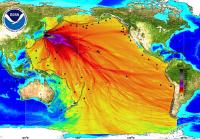The article Fukushima Emergency debunks the fancy we-re-all-gonna-die chart that’s also been making the rounds (shown below).
 Purported chart of Fukushima radiation (it's not)
Purported chart of Fukushima radiation (it's not)
“However, that chart did not actually track or measure radioactive discharge emanating from Fukushima in 2013, or any other aspect of the Fukushima disaster. It was a plot created by the National Oceanic and Atmospheric Administration (NOAA) immediately after the Tohoku earthquake in March 2011 showing the wave height of the tsunami that followed. It had (and has) nothing to do with the flow or spread of radioactive seepage from Fukushima.”
Nice. Take a chart from 2011 about a completely different topic and use it to “prove” that people are being duped by Tepco about the radiation in Fukushima. I think Californians can breathe easy, at least as far as dying from Fukushima radiation is concerned.
““The Pacific Ocean is an enormous place,” said Norman, who found radiation from the Fukushima nuclear power in California rainwater, milk and plants soon after the earthquake and tsunami. “There’s a lot of material between us and Japan. No matter what happens in Fukushima, it’s not going to be a problem over here.””

